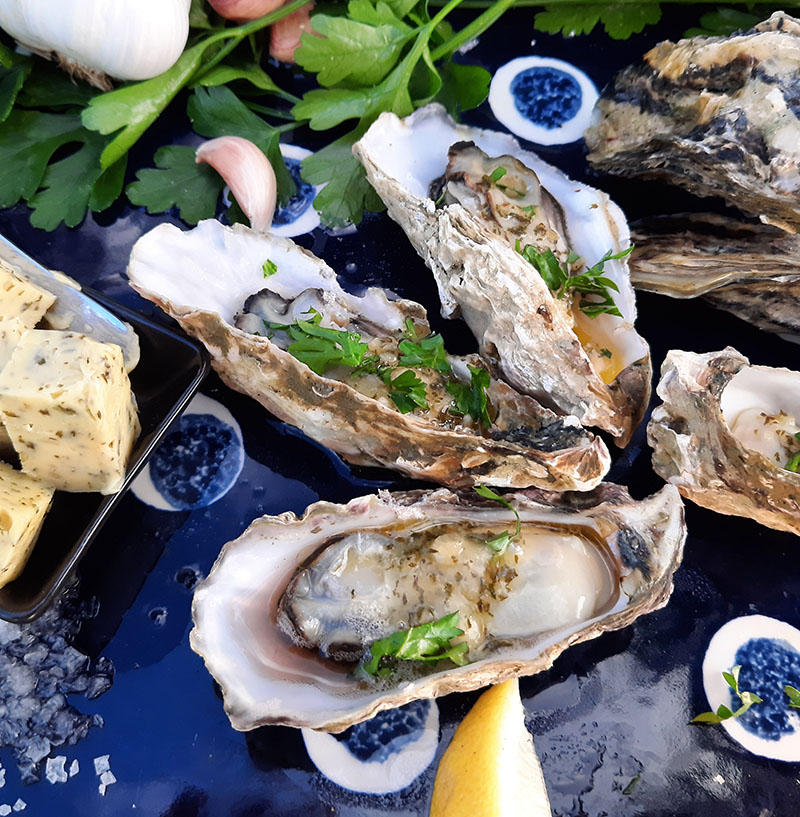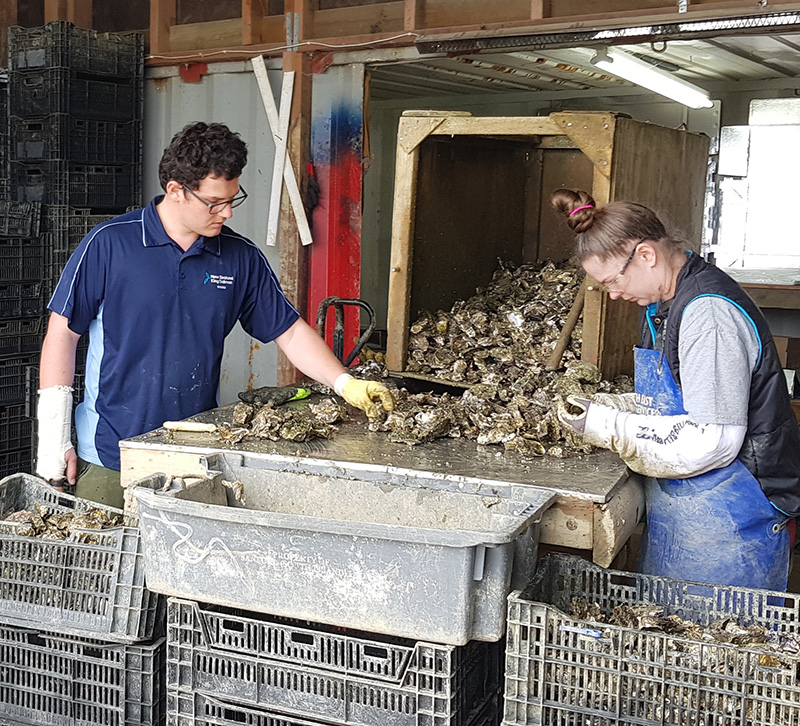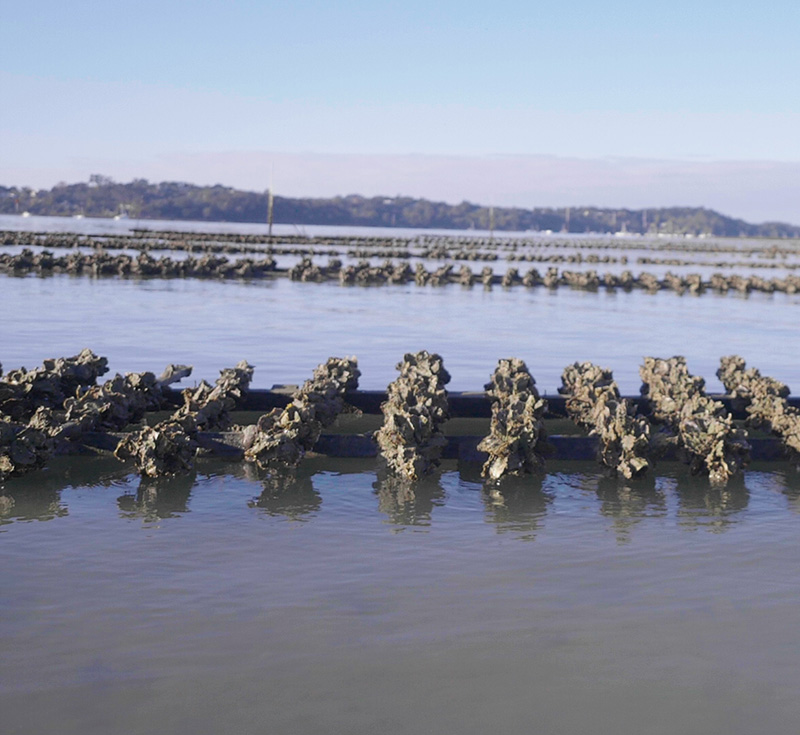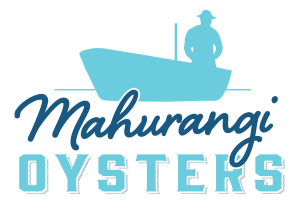Fresh Oysters.
“Shuck, that’s good.”
It’s about finding the perfect spot.
Like wine, oysters take on the flavour of their environment.
Just as grape varieties can produce wildly different results depending on the soil, oysters develop differently depending on their environment. Growing sweet, delicate Mahurangi oysters to the size, taste and consistency treasured by both chefs and our loyal customers is no accident.
“Sweet and plump, crisp and crunchy, salty and succulent, pick an adjective for the freshly shucked Mahurangi oyster in winter, and they all apply.” Oysters are affected by stocking density, nutrient density, water composition and temperature. We grow ours in the unpolluted waters of the Mahurangi Harbour, a perfect marine environment for pacific oysters to flourish.
Tuned to the lunar cycle, oysters are also influenced by moonlight and tides. They are crisp when the moon has waned but become progressively creamier as the moon gets full and the tides are highest. Oysters also vary in taste according to the seasons. They love the cold, and though they’re good to eat in the autumn and spring, it is over winter that some of the sweetest oysters of the year are harvested.
We take the greatest care and pride in producing the very best, freshest, tastiest live oysters – no compromise!

Exquisitely sustainable.
Oysters really are incredible little creatures. Wild-caught oysters are a taste sensation and are environmentally friendly. Your love for fresh oysters can help the planet because oysters have amazingly positive effects on the environment in which they grow.
They are sedentary filter feeders. Yet while lounging around gorging themselves on algae, each oyster processes 18 litres of seawater per hour as they help clean up the surrounding waters. Oysters remove excess nitrogen from the water, using it to construct their shells and can store carbon better than trees.
For a world that’s experiencing a crisis in ocean health and marine pollution, oysters are a deliciously sustainable choice.
Farmed oysters: one of the best investments you can make.
Oyster farming is the most sustainable kind of way of producing protein. At around ten dollars, half a dozen fresh oysters can provide more nutrition than nearly any other food for the same price. In addition, those six oysters would have filtered and cleaned over a quarter of a million litres of seawater during their 1 to 2 years of life.
Unlike other farmed seafood, such as salmon or prawns, oysters require no feeding. Eat farmed oysters and you are doing the environment and your body good.
Low in calories, high in protein and loaded with nutrients, fresh oysters are a ridiculously healthy choice.
Mahurangi oysters’ superpowers.
They are a great natural source of zinc, crucial for a strong immune system. Only five oysters a day will give an adult their full daily zinc requirement. Oysters are loaded with omega 3s, that your brain and heart adore, as well as vitamins D, B1, B12, B3, iron, protein and niacin. They also contain selenium, magnesium, manganese, copper, and phosphorus: all essential for health and well-being.
That’s quite a nutritional powerhouse wrapped up in one ugly little bivalve. But wait, there’s more. Oysters are super-high in protein but super-low in both fat and calories, making them favourites with both dieters and gourmands. Perfect.
How we do it in the Mahurangi.
Each oyster takes one-and-a-half years to grow before we harvest them for market. Our oysters are graded, and hand selected to order.
Oysters grow from ‘spat to fat’. Millions of wild-caught spats – baby oysters – are spawned in summer between January and March. This wild spat is collected in spat traps which are placed on inter-tidal racks where the tides wash over them twice each day. They are removed from the traps and placed in tumblers before being moved to flip baskets where they are left for around 13 months to “stay in their beds all day long; the only work they do is opening and shutting their shells; their meals are delivered to them, and they spend most of their lives drinking, putting away on average 180 litres a day”, as the New Zealand Geographic puts it.
During harvesting, mature oysters are removed from the flip baskets on the farm and put into a tumbler on the harvesting barge to be cleaned. They are then taken back by our flat-decked barge to land to be sorted and sent out in cardboard or poly-boxes. Any undersized oysters are packed loosely into flip baskets and returned to our oyster farms until they’re ready.

Natural-caught oysters are a seasonal food with three distinct phases.
Pacific oysters have a fresh, salty flavour that is truly addictive. Naturally caught oysters are at their full-flavoured, meaty best in winter through to early summer. We harvest and sell these oysters from April through to December when our oysters are fat and creamy. But because we won’t compromise on our quality, we don’t sell naturally caught oysters between January and March. This is their growth and recovery period after spawning and oysters eaten during this period are less succulent.
- April – September: They are crisp, meaty and plump.
- October – December: They are fat and creamy.
- Jan – March: This is the recovery phase for oysters where they are thin and less appealing.
- December – April: We have triploid oysters available. These are hatchery grown and do not mate during the summer months.

The oyster of choice.
Thanks to our careful husbandry and intelligent market selection, our plump Pacific oysters have become the oyster of choice in the Auckland restaurant scene and are exported in large numbers to Pacific Rim countries.
Feel free to contact us directly should you want more information. As a family business, we are very proud of what we produce and sell – and we only sell the best.
